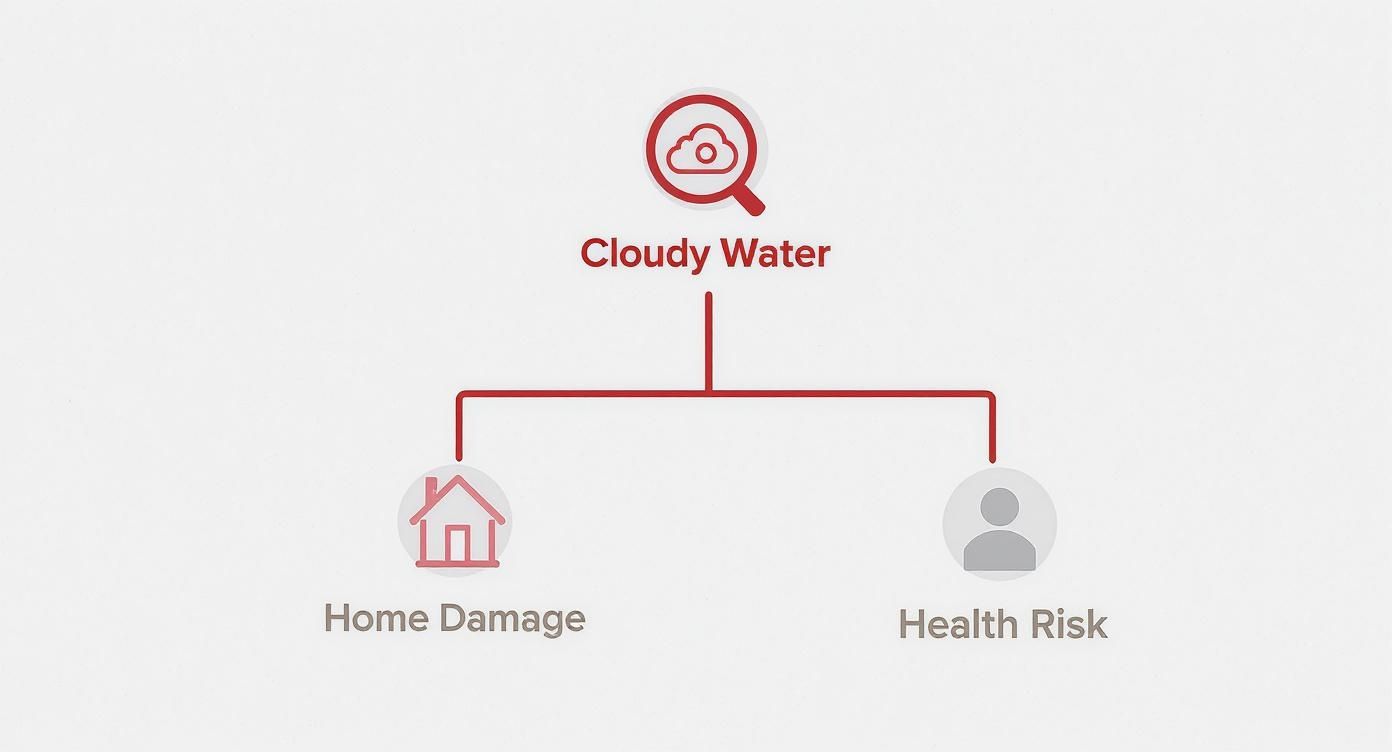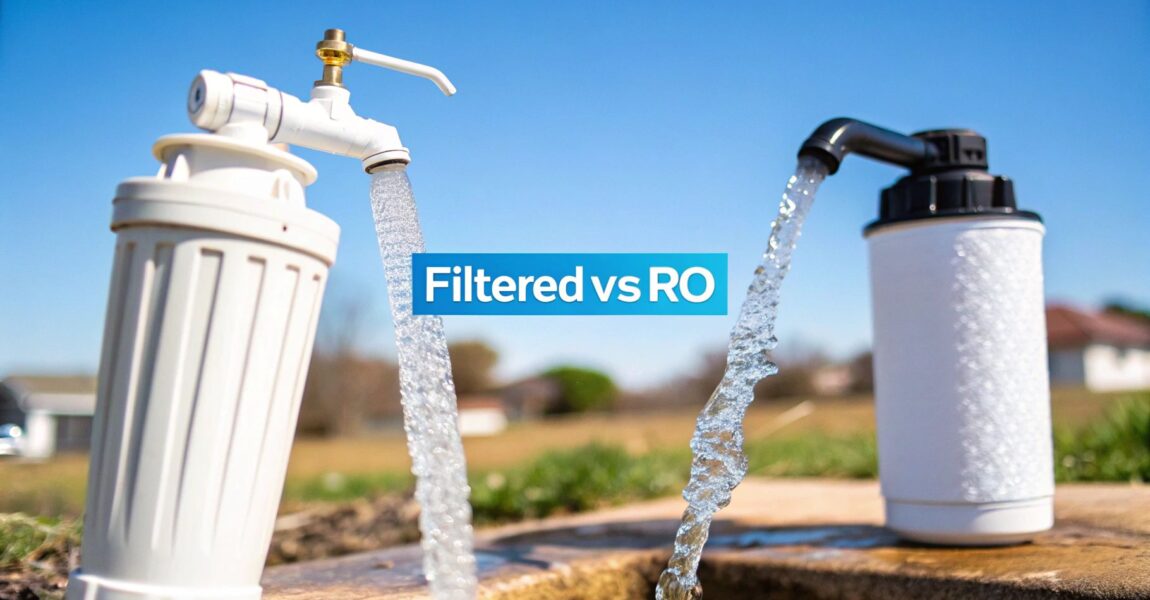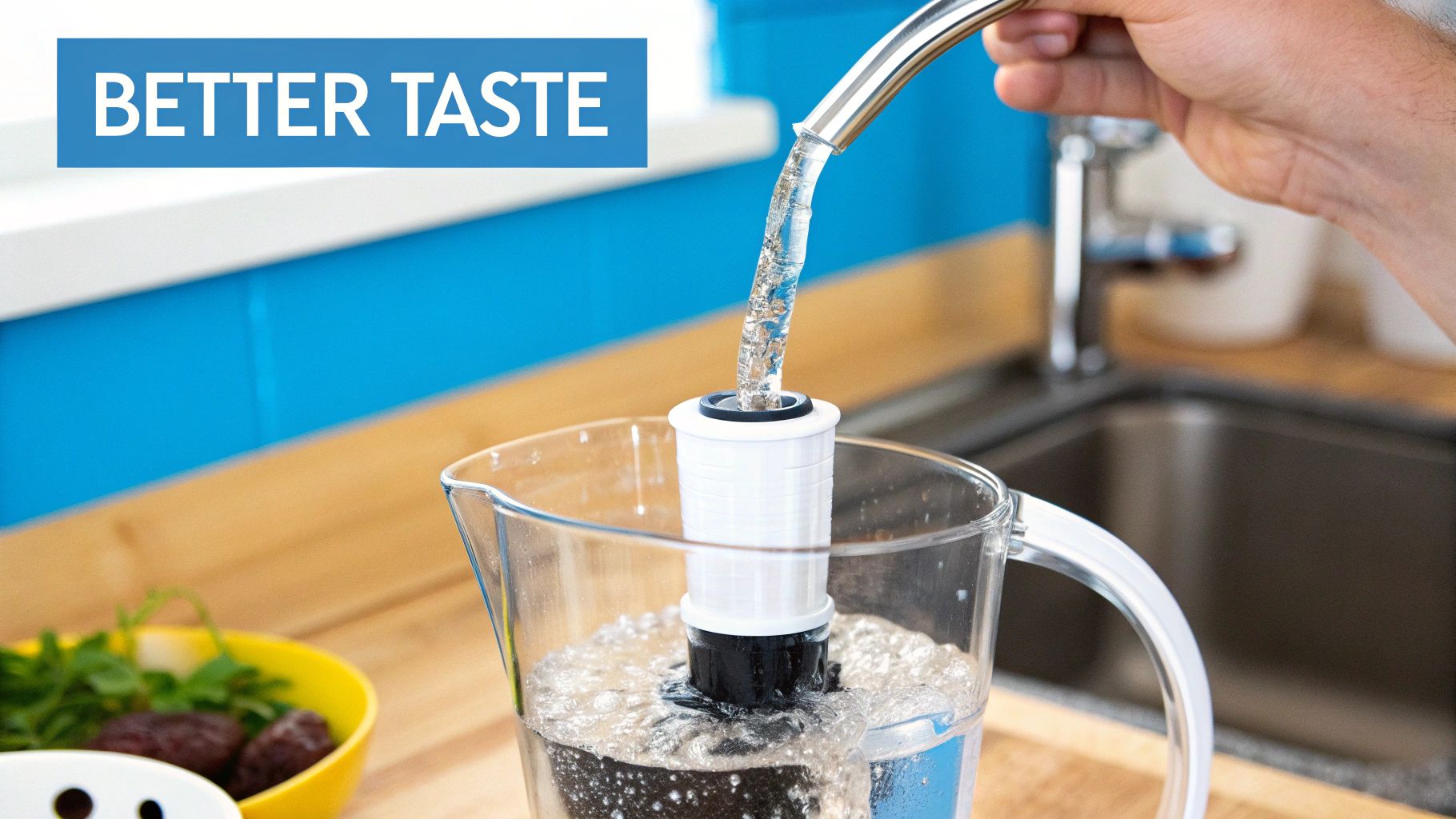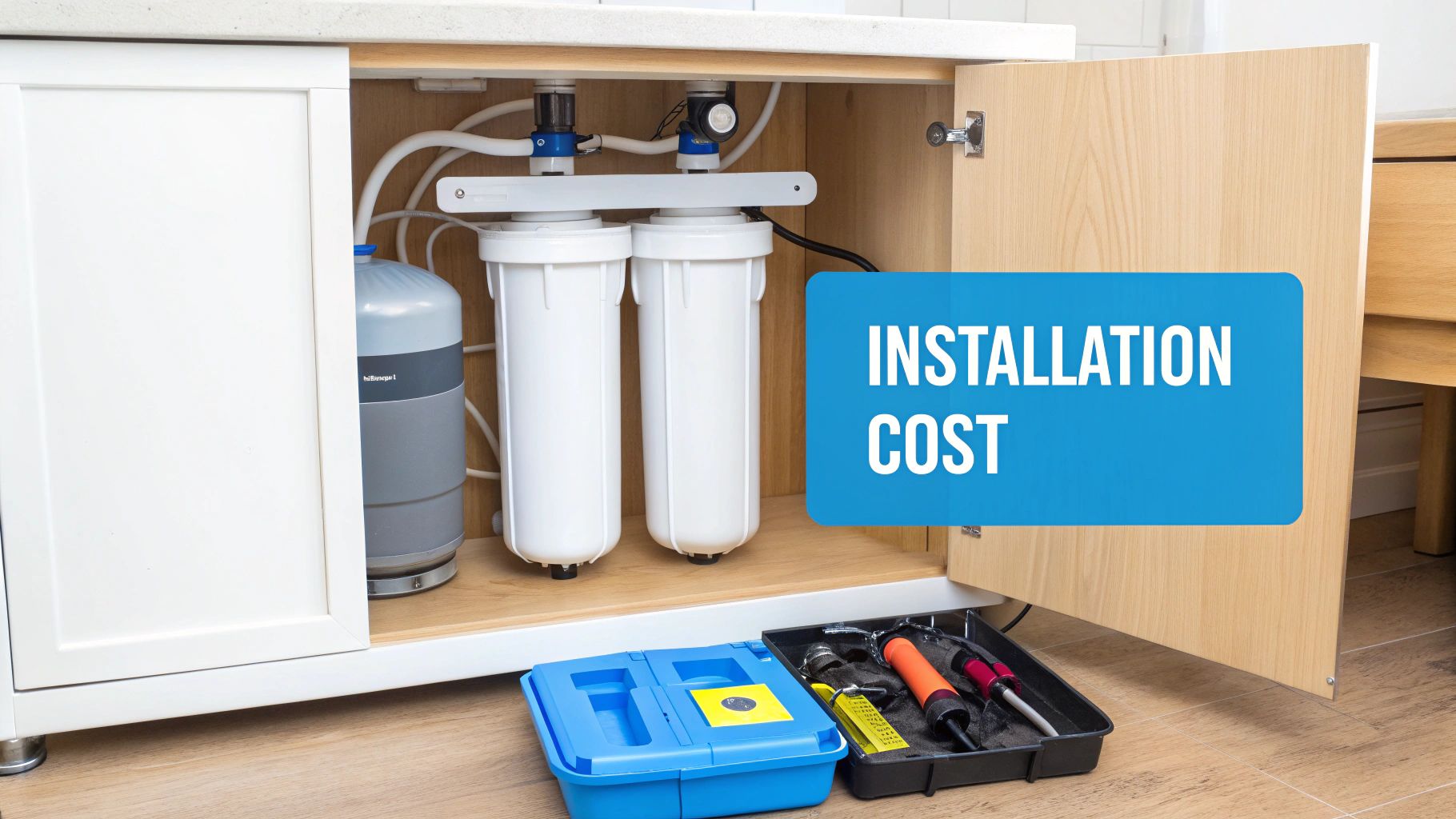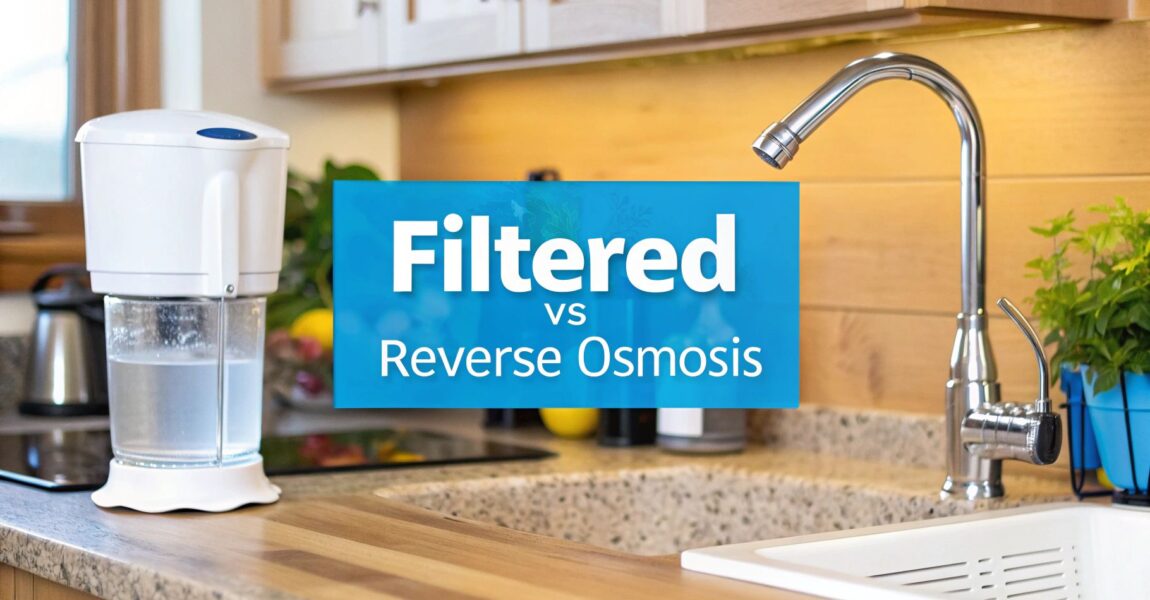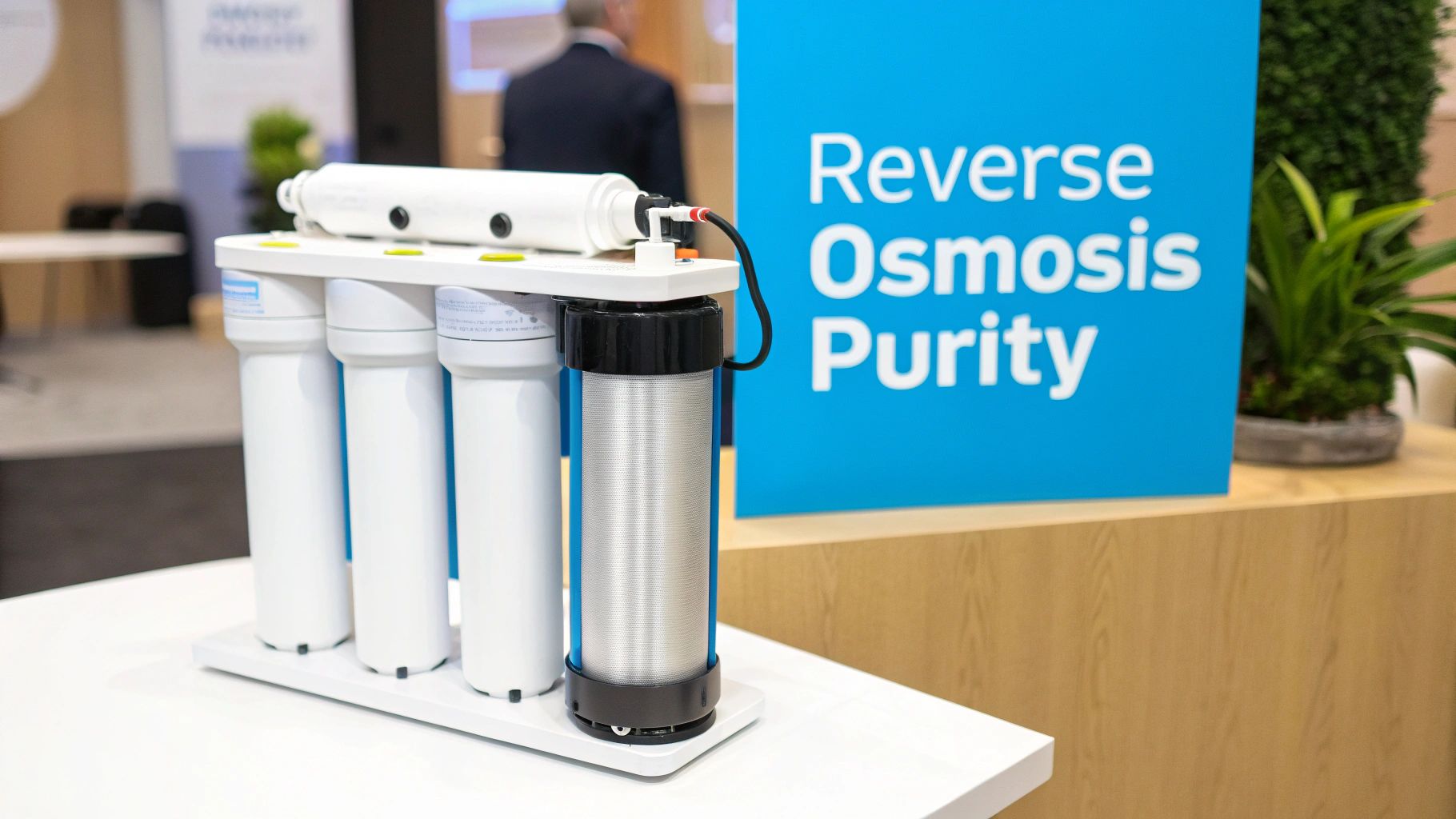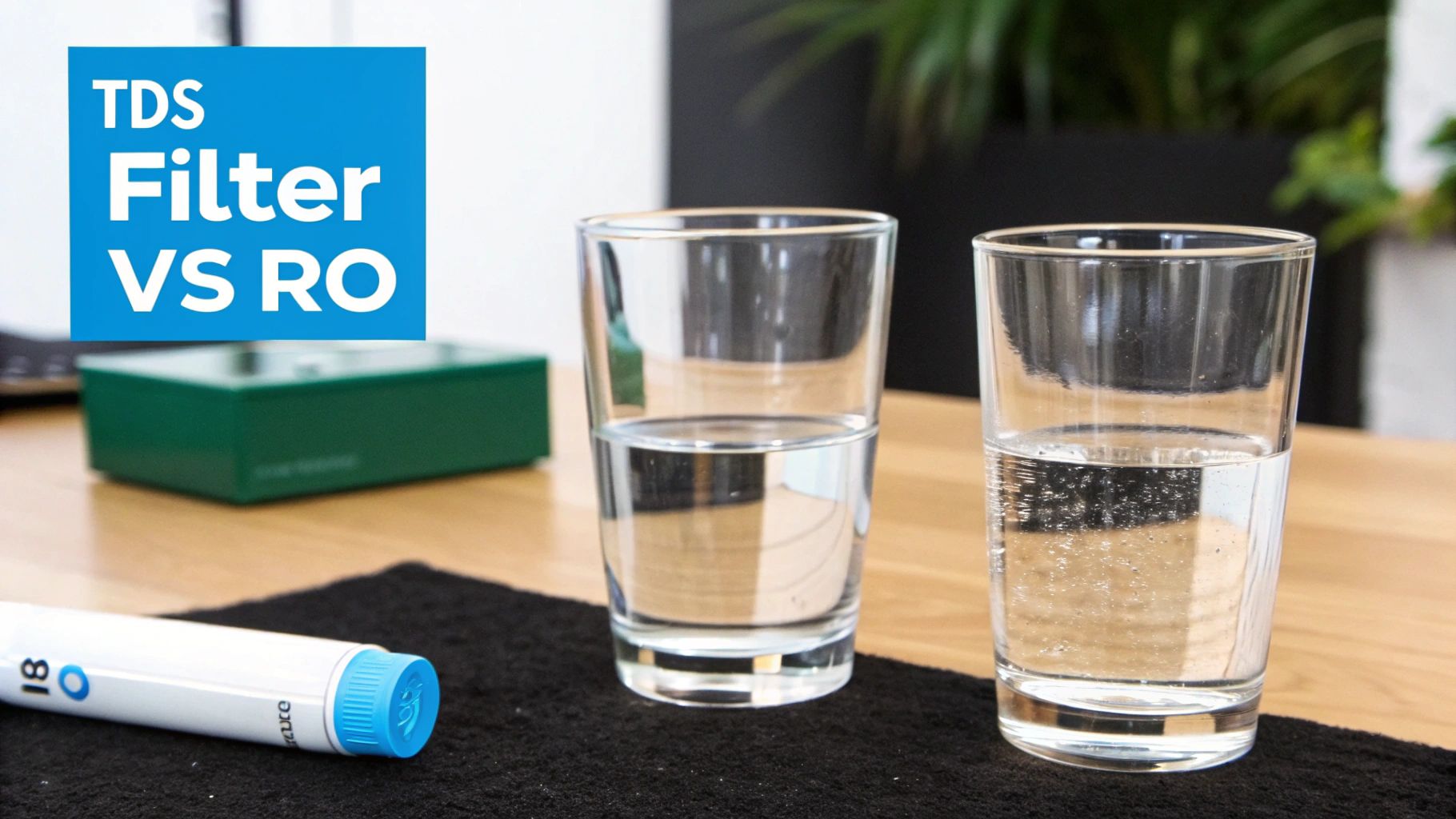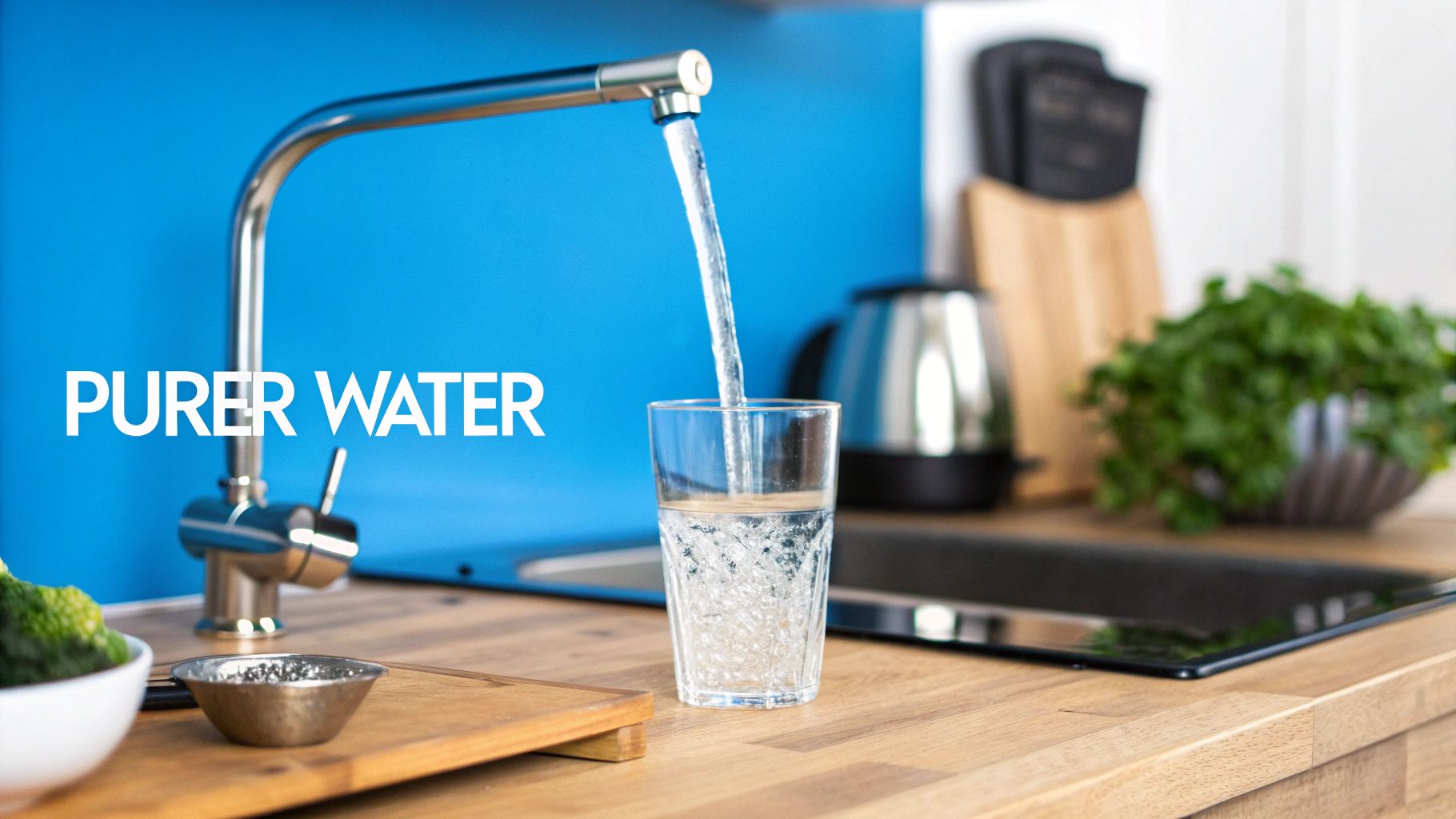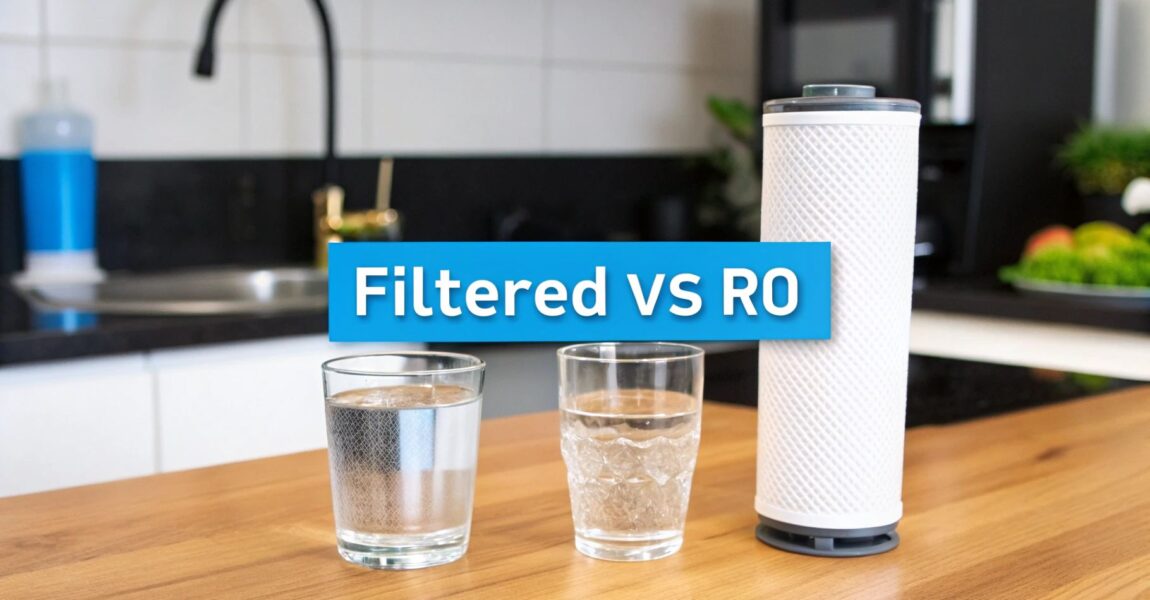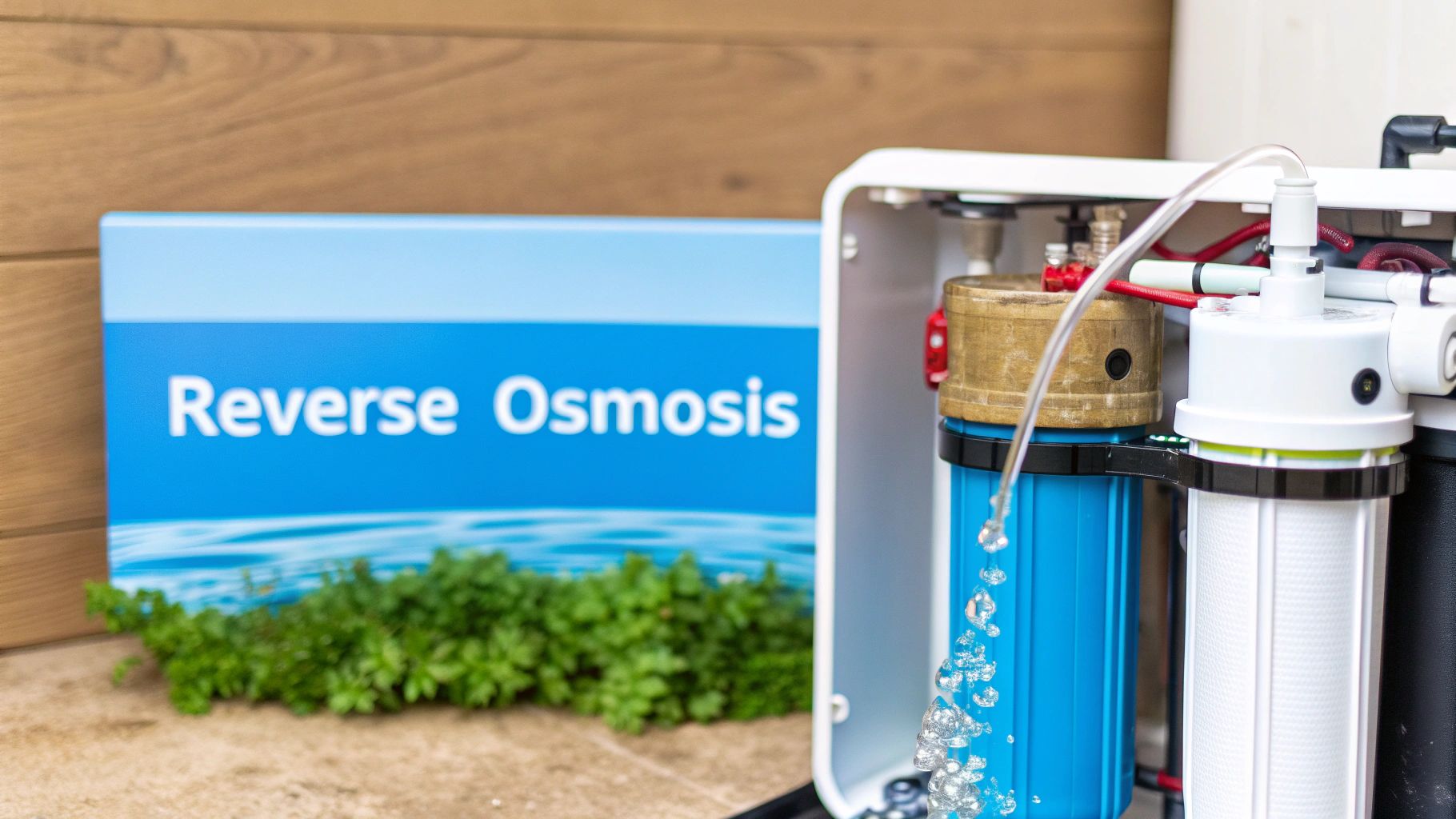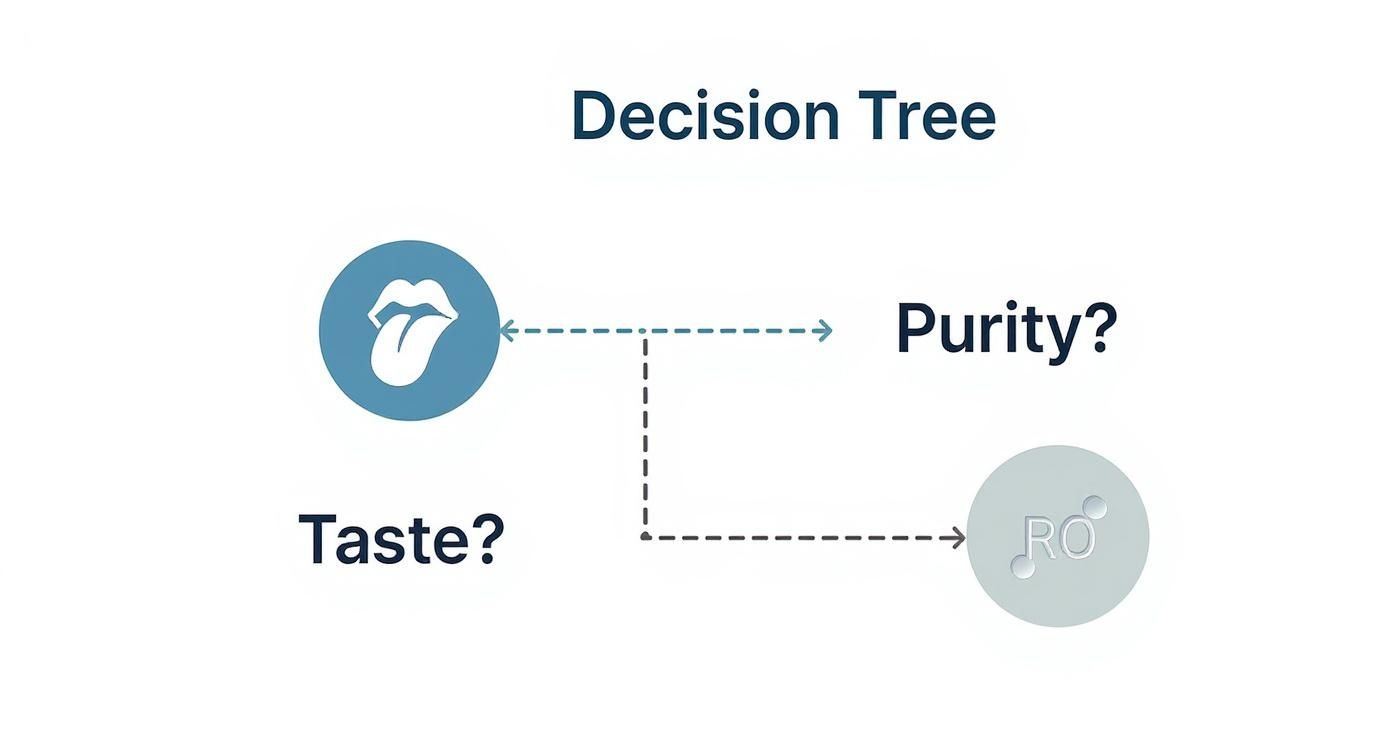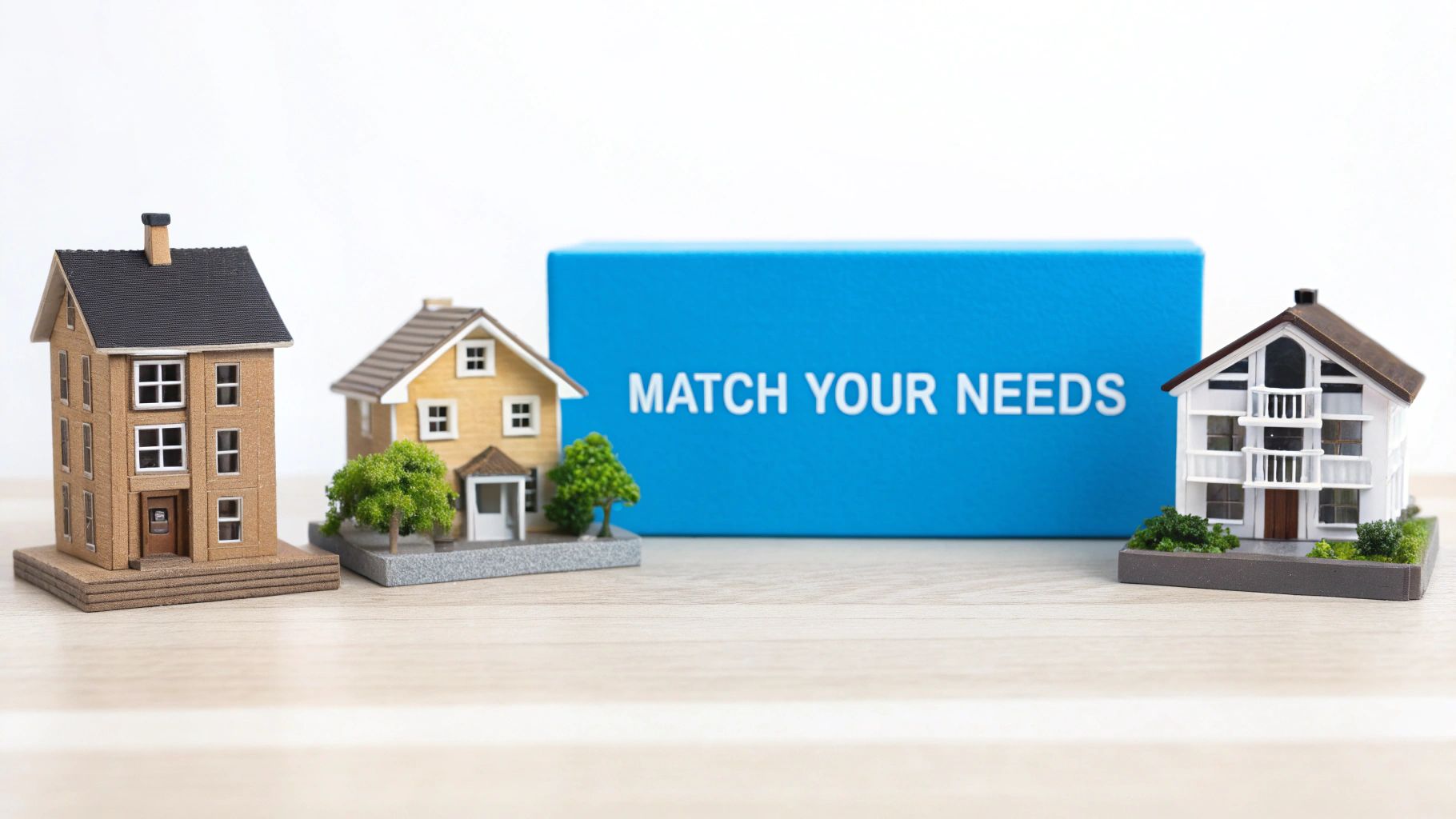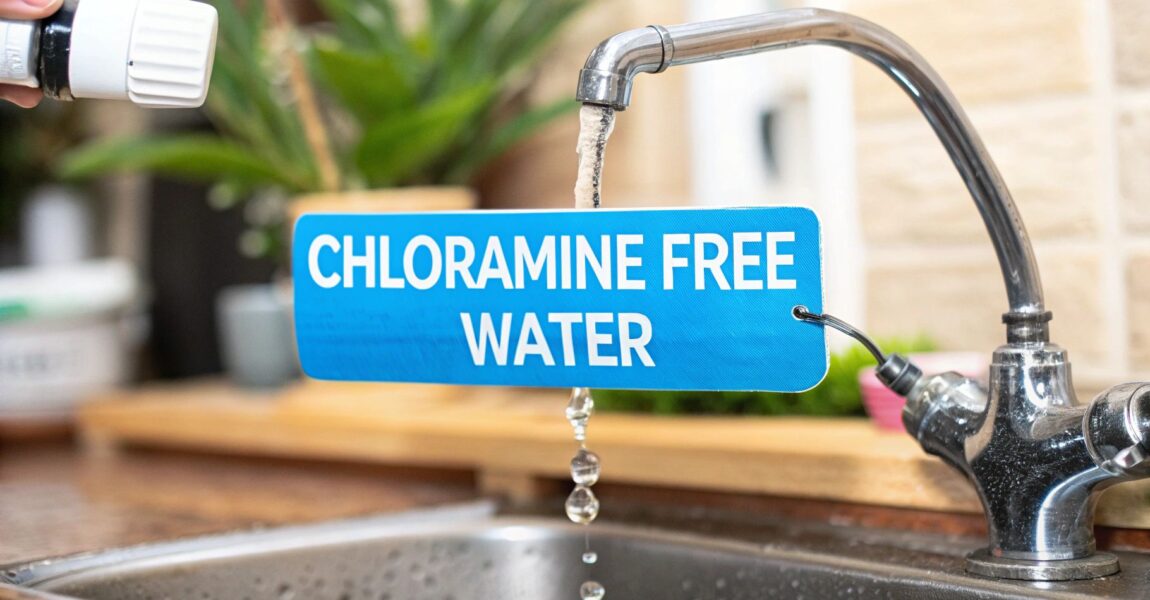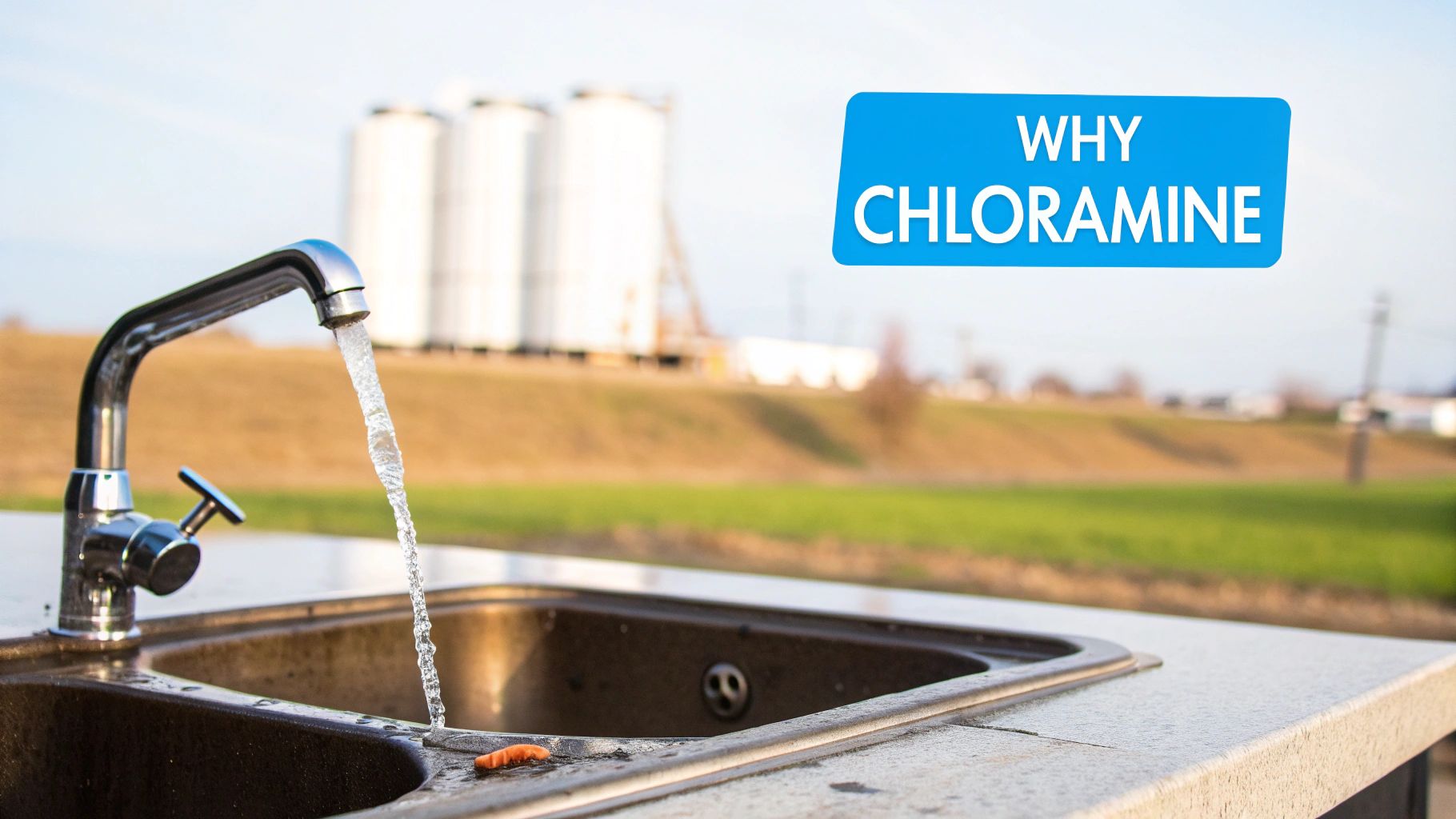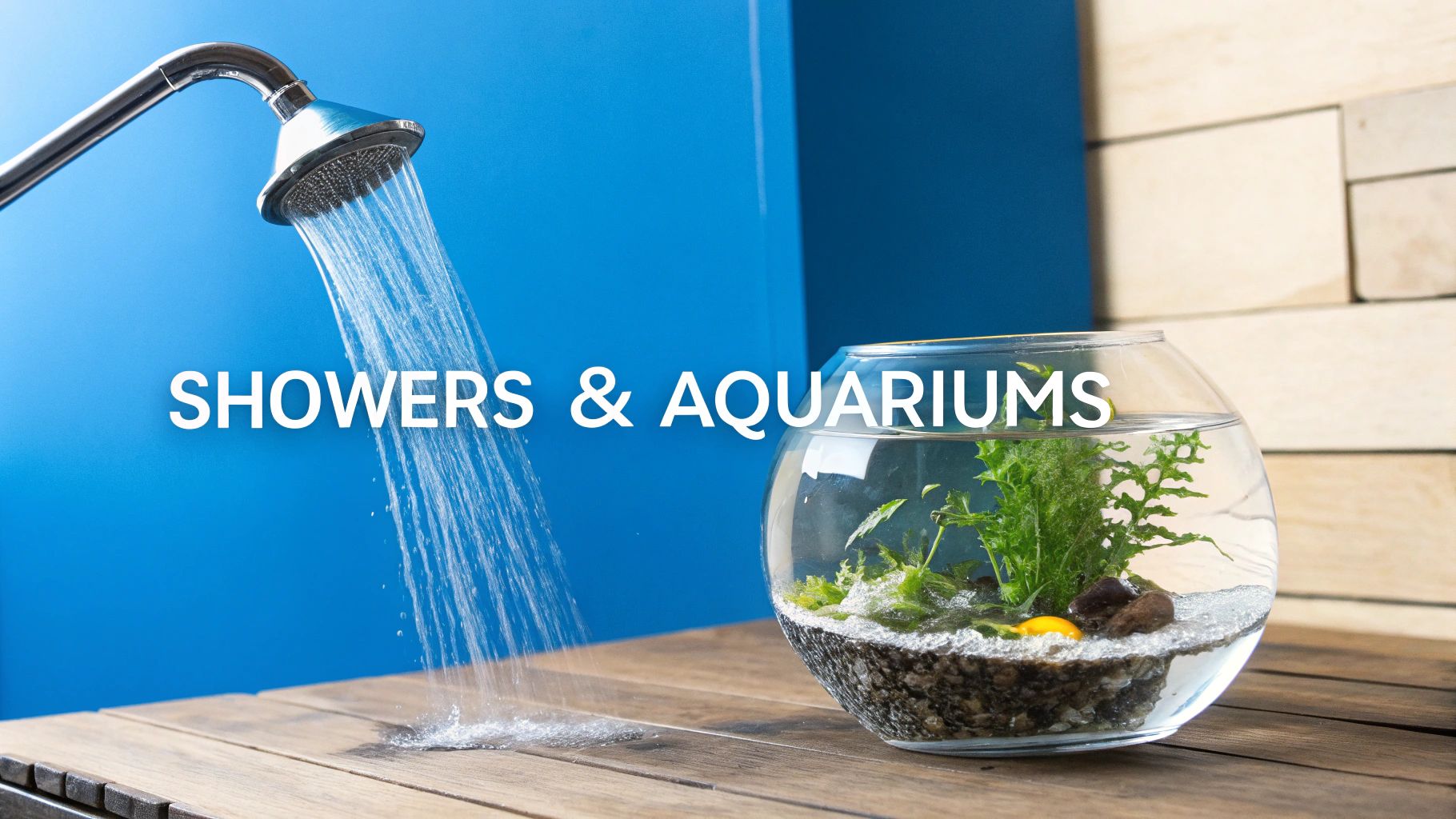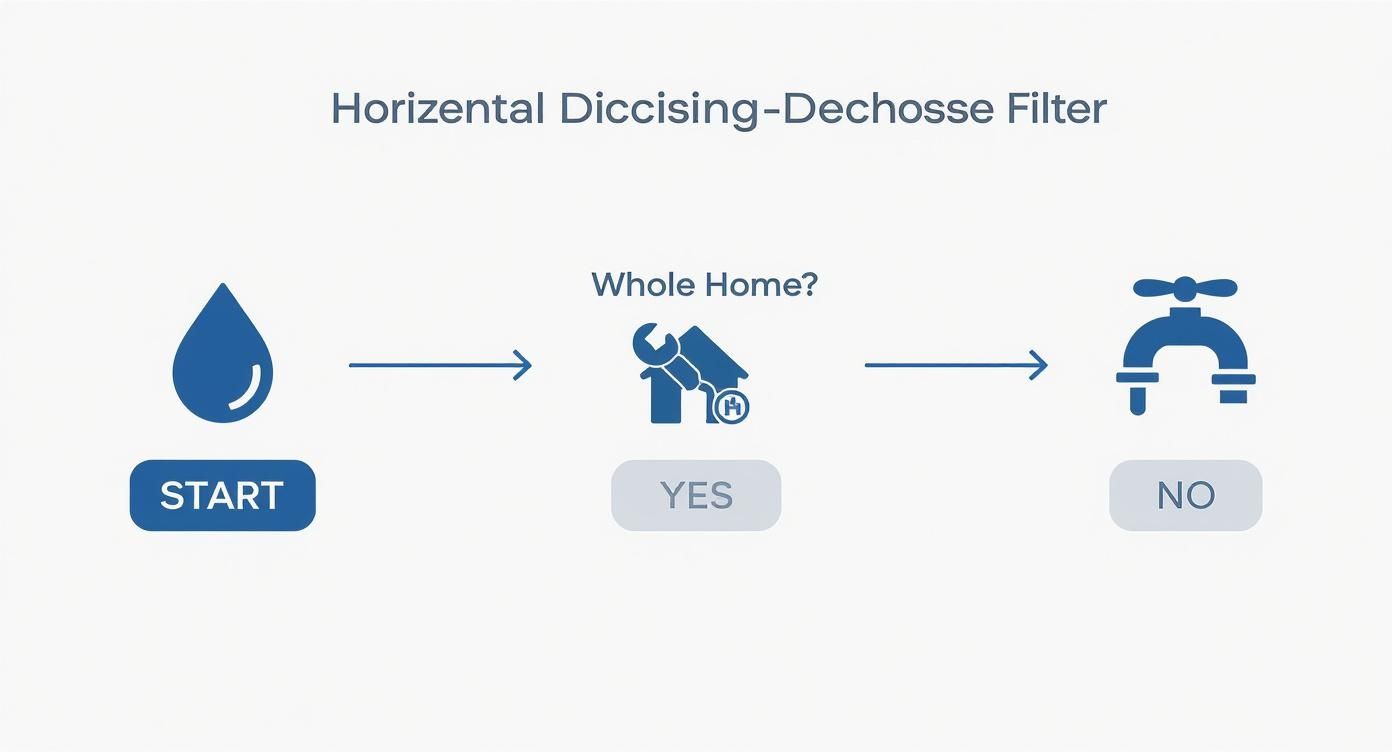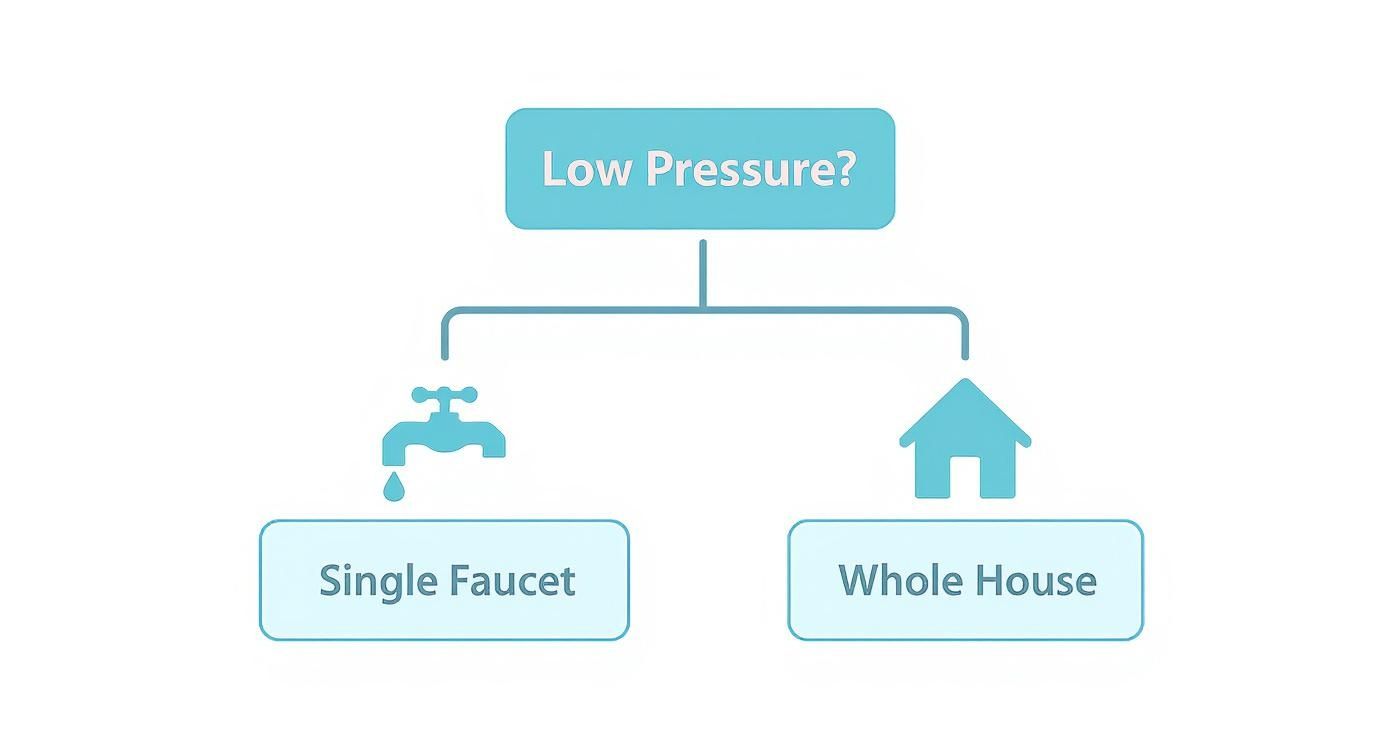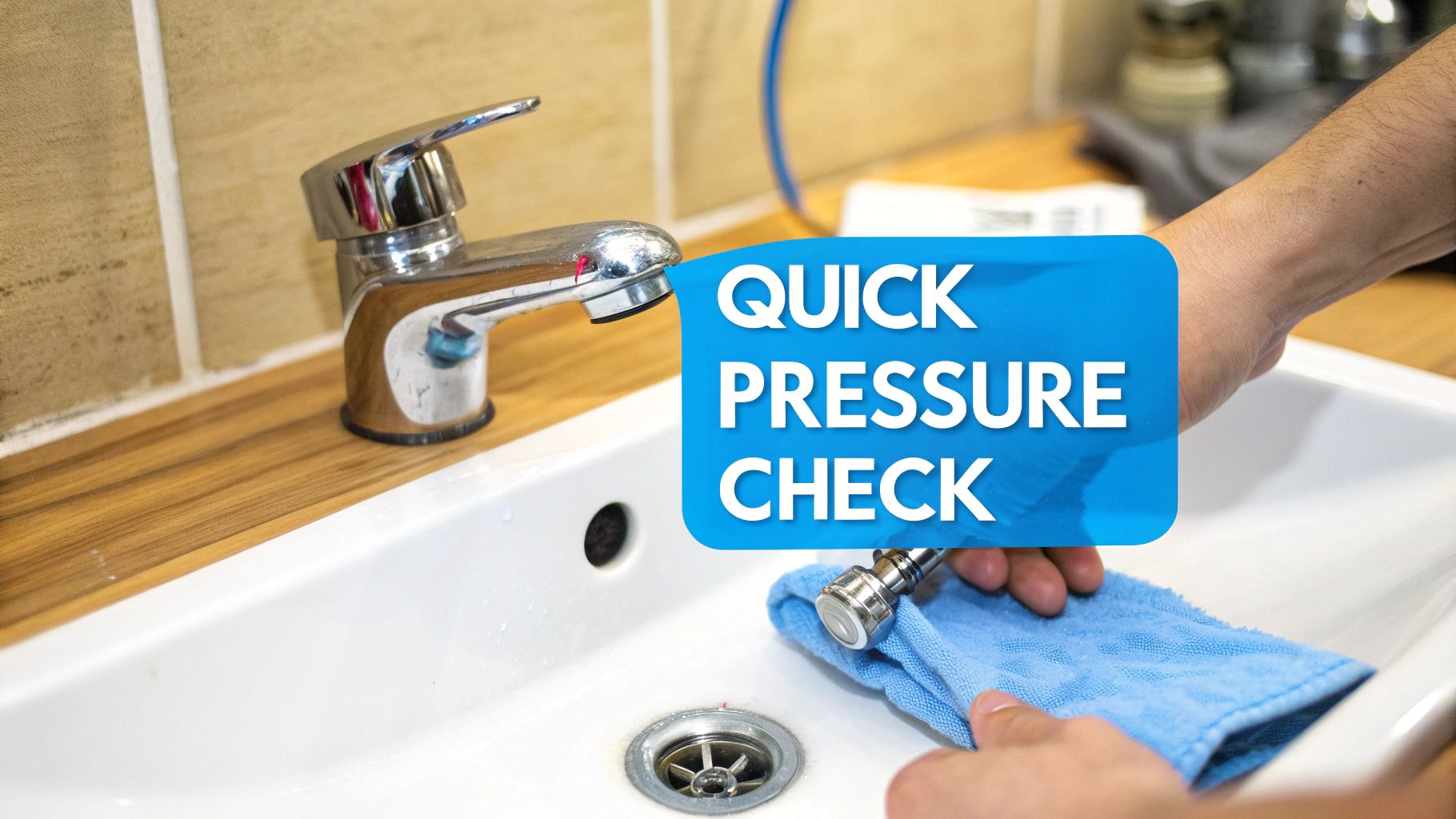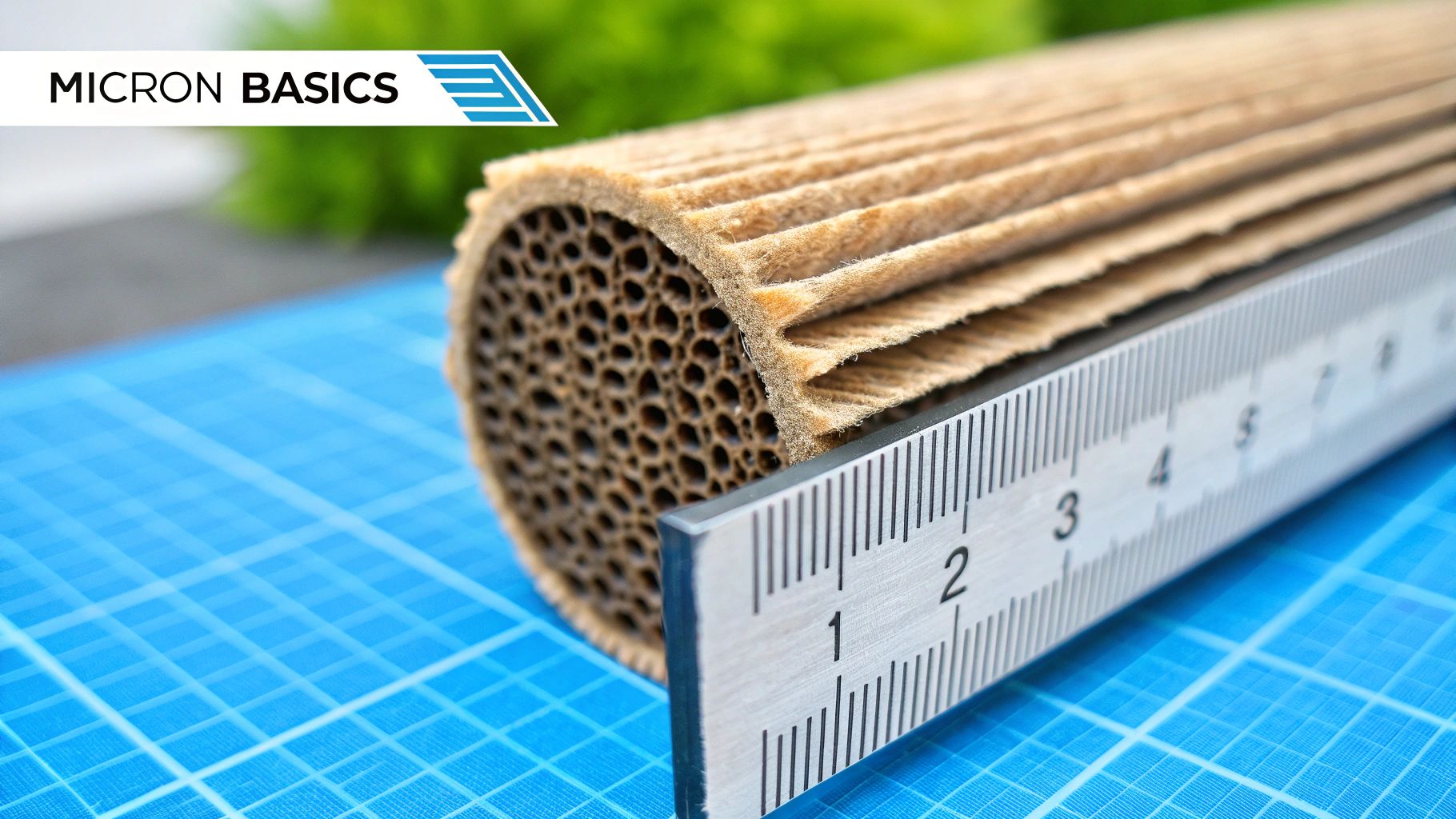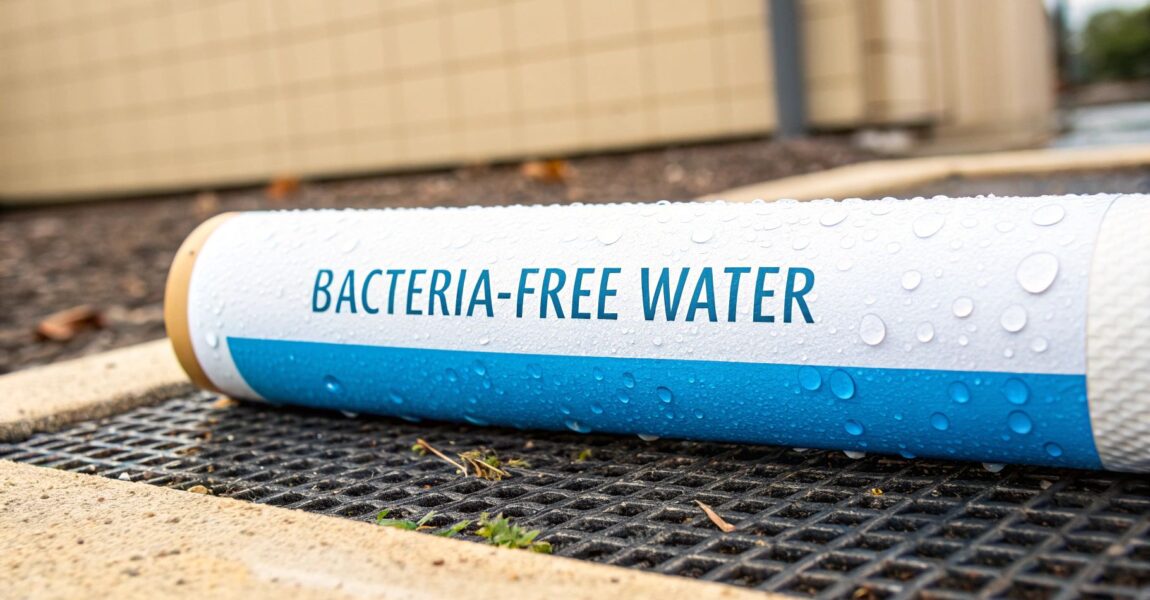
Can Reverse Osmosis Zap Bacteria? The Surprising Truth
So, you're eyeing that reverse osmosis system for your kitchen and wondering, "Can this thing really handle the nasty stuff, like bacteria?" The short answer is a big, confident yes. A well-maintained RO system isn't just a water filter; it's a microscopic bouncer, kicking nasty microbiological contaminants out of your drinking water.
It acts as a physical fortress, ensuring the water that fills your glass is incredibly pure and safe to drink.
How Reverse Osmosis Wins the Fight Against Bacteria
If you're even a little worried about what might be swimming in your tap water, you need a solution you can count on. Reverse osmosis is the heavyweight champion of home water filtration, designed to tackle these invisible threats right under your kitchen sink.
The real hero of the story is the RO membrane. This isn't just any filter; it's a high-tech sheet packed with microscopic pores measuring a ridiculously small 0.0001 microns. To give you some context, your average bacterium is a clumsy giant in comparison, measuring anywhere from 0.2 to 10 microns wide. In this game, size is everything—bacteria are simply too big to get through the door.
A Tough-as-Nails Physical Gatekeeper
Imagine the RO membrane as the world's most exclusive nightclub bouncer. It doesn't use chemicals or tricks to zap germs. Instead, it uses your home's water pressure to push tiny, pure water molecules through its super-fine surface while telling almost everything else, "You're not on the list."
This means it physically blocks and flushes away larger contaminants down the drain, including:
- Bacteria like the notorious E. coli and Salmonella
- Viruses that can ruin your week
- Protozoa such as the dreaded Giardia and Cryptosporidium
This simple method of physical separation is what makes RO systems so incredibly reliable. In fact, the U.S. Centers for Disease Control and Prevention (CDC) points to reverse osmosis as a top-tier technology for kicking pathogens to the curb. A good system can get rid of more than 99% of bacteria, making it the go-to choice for homeowners who want genuine peace of mind with every sip.
A reverse osmosis system gives you a final, powerful line of defense right in your kitchen. It purifies the water you drink and cook with just moments before you use it.
By installing an RO system, you're putting a formidable barrier between your family and potential dangers lurking in both city and well water. It’s a foundational piece of any modern, safe home.
How Reverse Osmosis Performs Against Contaminants
To put it all in perspective, here's a quick look at how a typical residential RO system stacks up against various common contaminants. It's a true multi-stage workhorse.
| Contaminant Type | Example | Typical Removal Rate |
|---|---|---|
| Microbiological | E. coli, Giardia, Viruses | 99%+ |
| Heavy Metals | Lead, Arsenic, Mercury | 95% – 98% |
| Dissolved Solids | Salt, Fluoride, Nitrates | 90% – 99% |
| Chemicals | Chlorine, Pesticides | 98%+ (with carbon pre-filter) |
As you can see, while RO is an absolute champion at removing bacteria and a wide range of other tough contaminants, its performance can depend on the specific substance. This is why multi-stage systems that include sediment and carbon filters are the standard.
How Reverse Osmosis Physically Blocks Bacteria
To really get how reverse osmosis (RO) handles bacteria, you have to think small. Really small. Imagine trying to shove a basketball through a keyhole—it’s just not going to happen. That’s the same genius principle behind an RO system, but on a microscopic level. It's a purely physical barrier, like a bouncer at a club who only lets the cool, small molecules through.
The heart of any RO system is its semipermeable membrane. This isn't your average coffee filter; it's an incredibly fine material with pores so tiny they're measured in angstroms. To put that in perspective, a typical RO membrane has pores around 0.0001 microns wide.
Now, let's talk about the bad guys. Bacteria like E. coli or Salmonella are tiny to us, but compared to an RO membrane's pores, they're absolute giants. A single bacterium can be anywhere from 0.2 to 10 microns in size, making it thousands of times too big to squeeze through. No VIP pass, no entry.
The Science of Size Exclusion
The process itself is both simple and powerful. Your home’s water pressure pushes water against this membrane. The water molecules, being exceptionally small, are forced through the tiny pores and collect on the other side as wonderfully purified water.
Meanwhile, all the larger contaminants get left behind. They simply can't pass through the membrane and are unceremoniously flushed down the drain. This rejected list includes a whole bunch of things you don't want in your glass:
- Bacteria: Physically blocked and washed away.
- Viruses: Also too large to pass through the 0.0001-micron pores.
- Protozoan Cysts: Things like Giardia and Cryptosporidium don't stand a chance.
- Dissolved Solids: This includes heavy metals like lead and arsenic, plus minerals like salt and fluoride.
This elegant process of "size exclusion" is what makes RO so incredibly effective. It doesn't need chemicals to kill or neutralize bacteria; it just flat-out denies them entry. So when someone asks, "can reverse osmosis remove bacteria?" the answer is a resounding yes—it physically separates them right out of your water.
This diagram helps visualize how the RO membrane acts as a gatekeeper for different contaminants.
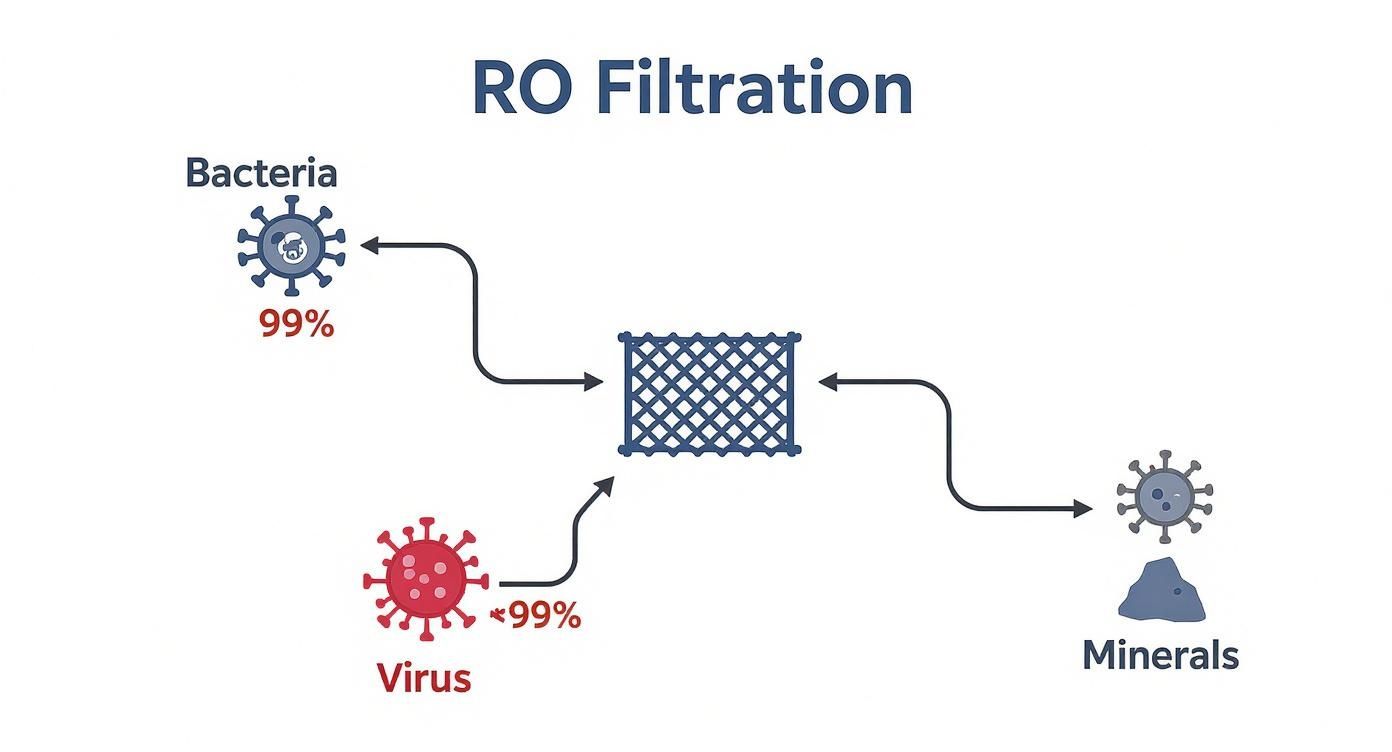
As you can see, the membrane is a rock-solid barrier against not just bacteria, but also viruses and dissolved minerals, giving you truly comprehensive purification.
Proven Performance You Can Count On
And this isn't just talk—the effectiveness of reverse osmosis has been tested time and again. Its ability to remove bacteria is a well-documented scientific fact, not just a marketing claim. In fact, study after study shows that membrane filtration is one of the most reliable ways to achieve microbiological purification.
One major review of water treatment methods found that reverse osmosis achieved a bacterial removal rate of about 99.997%. That incredible level of performance is why RO isn't just used in homes; it's trusted in critical places like hospitals and bottled water plants. If you're curious, you can dive deeper into the research on membrane filtration effectiveness and see the data for yourself.
The real strength of reverse osmosis is its consistency. As long as the membrane is intact and the system has enough pressure, it will reliably block bacteria and other pathogens every single time you turn on the faucet.
This mechanical separation gives homeowners a powerful and dependable final line of defense. Even if your city issues a boil water advisory, a properly working RO system under your sink ensures the water you drink is still safe. It puts you back in control of your water quality.
Understanding the Limits of an RO System
A reverse osmosis system is an absolute beast when it comes to water purification, but it's not a "set it and forget it" magic box. Think of it like a high-performance sports car—it delivers breathtaking results, but only if you keep it tuned up. Its power to consistently block bacteria depends entirely on the system's integrity and your commitment to proper maintenance.
Knowing the system's limits isn't about being negative. It's about being smart so you can keep it running at peak performance, ensuring your family gets the safest, purest water possible.

The Critical Role of Membrane Integrity
The heart and soul of an RO system is its semipermeable membrane. This is the super-fine barrier that physically stops bacteria in their tracks. But this membrane is delicate. Over time, it can get damaged, developing microscopic tears or holes you'd never see with the naked eye.
Even a single, tiny breach can become a microscopic superhighway, letting bacteria and other nasty contaminants sneak right past the filtration process. This is, without a doubt, the biggest vulnerability of any RO system. Once that membrane is compromised, it's no longer the near-perfect shield you're relying on.
This is exactly why routine maintenance and changing the membrane on schedule aren't just polite suggestions—they are absolutely essential to keep your system working like a true microbiological purifier.
The Unsung Heroes: Pre-Filters
Long before water ever gets to the RO membrane, it has to pass through a couple of other filters first. We call these pre-filters, and they are the unsung heroes of your system. They're the bodyguards, and their job is critical.
Typically, you'll have two kinds:
- Sediment Filter: This is the bouncer at the front door. It grabs all the bigger stuff like sand, rust, and dirt. Without it, these gritty particles could literally scratch or tear the delicate RO membrane, dramatically shortening its life.
- Carbon Filter: This filter's job is to remove chlorine and other chemicals. Chlorine, which is used to disinfect most city water, is incredibly harsh on the membrane's material. It can eat away at it over time, causing it to fail.
By taking out these threats first, the pre-filters allow the RO membrane to focus on what it does best: tackling the tiniest and toughest contaminants, including bacteria.
The Sneaky Risk of Post-Filtration Contamination
Okay, so your RO system has done its job perfectly. The bacteria are gone, and you have pristine water. But the journey isn't quite over. After being purified, that water chills out in a small storage tank under your sink before it gets to your faucet. This is where a new, sneaky risk can pop up.
If the tank, the tubing, or the faucet itself isn't kept clean, it's possible for new bacteria from the surrounding environment to get in and start a party. Now, super-pure RO water is a terrible place for bacteria to thrive, but it's not impossible.
The key thing to remember is that an RO system purifies water as it's being made, not at the very instant you turn on the faucet. This makes sanitizing the whole system every year—including the tank and faucet—a non-negotiable part of your maintenance routine.
Interestingly, research shows that while some biofilm can grow in RO systems, the total number of bacteria is far, far lower than what you'd find in regular tap water. This tells us that RO doesn't just remove bacteria, it also makes it harder for them to grow back. You can dig into the full findings on bacterial regrowth in RO systems if you want the nitty-gritty details. It just goes to show that while the risk is low and totally manageable, it's still there and reinforces why regular cleaning is so important.
Creating a Bulletproof System with UV Light
For anyone who wants the absolute highest level of water safety—especially if you're on well water—pairing a reverse osmosis system with an Ultraviolet (UV) purifier is the gold standard. Think of it as a one-two punch for microbiological safety. Your RO system physically blocks bacteria and viruses, while the UV light zaps anything that might, by some miracle, sneak through.
This combination gives you a powerful safety net. Even if a tiny, unseen tear were to form in the RO membrane, the UV stage is right there to neutralize the threat. It's the ultimate peace of mind in a glass of water.
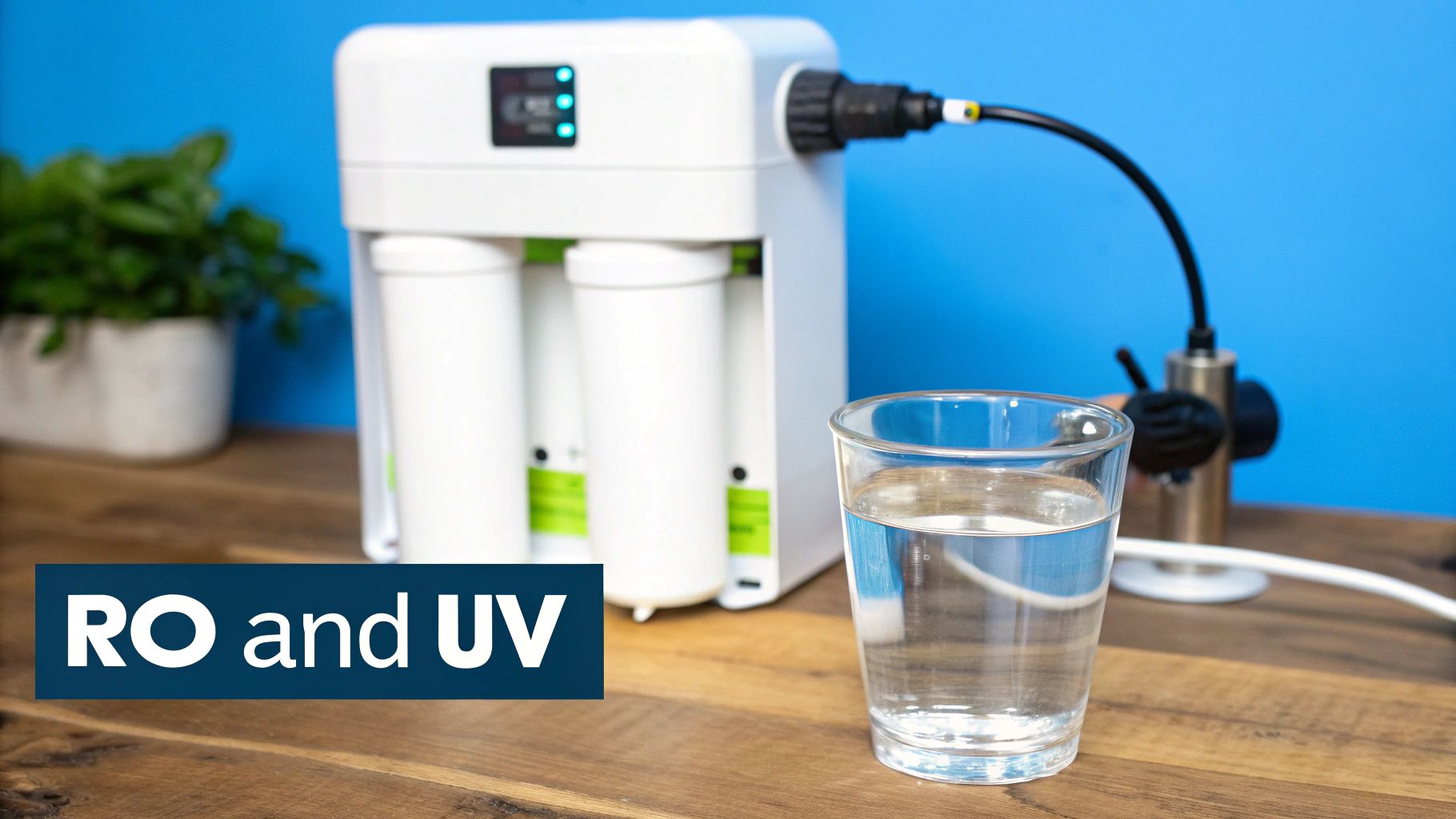
How UV Light Neutralizes Microbes
So, how does this UV light stage work its magic? It's a brilliant and straightforward process. A UV purifier is a chamber that blasts water with a specific wavelength of ultraviolet light—254 nanometers, to be precise.
This light is a natural germicide. It doesn’t kill microbes with poison; instead, it completely scrambles their DNA and RNA as they pass by the lamp. This instantly destroys their ability to reproduce or cause any harm. It’s like giving them a fatal sunburn that makes them totally inert.
The best part is that this whole process is:
- Chemical-Free: Nothing is added to your water, so there's no change to the taste or smell.
- Extremely Fast: Purification happens instantly as the water flows through the chamber.
- Highly Effective: UV is proven to neutralize 99.99% of common waterborne pathogens, including viruses that are too small for some filters to catch.
This combo provides a rock-solid answer to the question, "can reverse osmosis remove bacteria?" The RO membrane gets them out, and the UV light makes sure they stay out for good.
Comparing RO Alone vs an RO Plus UV System
While a standalone RO system is a fantastic filter, adding a UV stage takes your water purification to a whole new level. Deciding whether you need it often comes down to your water source and how much security you want against microscopic threats.
Here’s a quick breakdown of what each setup offers:
| Feature | Reverse Osmosis (Alone) | Reverse Osmosis + UV Purifier |
|---|---|---|
| Primary Mechanism | Physical barrier (membrane) | Physical barrier plus germicidal light |
| Bacteria Removal | Excellent (99%+ removal) | Exceptional (Adds a 99.99% kill rate) |
| Virus Removal | Excellent (99%+ removal) | Exceptional (Targets even the smallest viruses) |
| Post-Filter Security | Relies on system sanitation | Actively sterilizes water just before the tap |
| Ideal For | Most city water supplies | Well water, boil advisory areas, immune-compromised households |
The bottom line is that by adding a UV stage, you are no longer just filtering your water—you are actively sterilizing it. This is the best approach for anyone who simply can't afford to take risks with their water quality.
Is an RO/UV System Right for Your Home?
This powerful combination isn't necessary for every single household. If you're on a reliable city water system that is consistently free of microbiological problems, a high-quality RO system on its own is usually more than enough protection.
However, an RO/UV system becomes a critical investment in a few key situations. You should seriously consider this dual setup if:
- You use a private well. Well water isn't treated by a municipality and is much more likely to be contaminated by bacteria like E. coli from surface runoff.
- Your area has frequent boil water advisories. A combined system provides a reliable final barrier, protecting your family even when the public supply is compromised.
- You have vulnerable individuals at home. For households with infants, the elderly, or anyone with a compromised immune system, that extra layer of UV protection is invaluable.
Ultimately, combining RO with UV turns your water filter into a complete purification system. The RO handles the heavy lifting by removing everything from lead to salt, while the UV light delivers a final, targeted strike against any potential microbiological threat.
Your Simple Home Maintenance Checklist
Knowing how your reverse osmosis system works is great, but keeping it running like a well-oiled machine is what really counts. A properly maintained system is your number one defense against bacteria and other nasty stuff in your water. This checklist breaks down the essentials into simple, doable steps so your RO system can deliver pure, safe water for years to come.
Think of it like getting regular oil changes for your car. You wouldn't just skip them and hope for the best, right? The same logic applies here—a little consistent care goes a long way toward reliability and peace of mind.
Setting Your Filter Replacement Schedule
The filters are the workhorses of your RO system, and they need to be replaced on a strict schedule to keep that all-important RO membrane protected. If you want your system to actually remove bacteria, sticking to a replacement schedule is non-negotiable. Go ahead and mark these dates on your calendar or set a recurring reminder on your phone right now.
A typical RO system has a few different filter stages, and each has its own lifespan:
- Sediment Pre-Filter: This one catches the big stuff like rust and dirt. You'll want to swap it out every 6 to 12 months to stop it from getting clogged and causing problems for the other, more delicate parts of the system.
- Carbon Pre-Filter(s): These filters are crucial for removing chlorine, which will literally eat away at the RO membrane. Plan on replacing these every 6 to 12 months, too, as they lose their effectiveness over time.
- RO Membrane: This is the heart of the whole operation. If you've been good about changing your pre-filters, the membrane itself should last a solid 2 to 3 years. You'll know it's time for a new one if your water production slows to a crawl or you notice a change in taste.
- Carbon Post-Filter: This is the final "polishing" step that makes your water taste crisp and clean after it leaves the storage tank. Replace this one once a year to keep your water tasting great.
For a deeper dive into different filter types and how they all work together, you can find a ton of helpful resources and water filter advice from people who live and breathe this stuff.
Annual System Sanitization
Even with flawless filtration, the parts of the system after the membrane—like the storage tank, tubing, and faucet—can be a place for stray airborne bacteria to set up shop. This is exactly why an annual deep clean is so critical. Sanitizing the whole system once a year is a must-do step to prevent any bacterial regrowth and keep your water perfectly pristine.
The process is pretty simple. It usually just involves shutting off the water, draining everything, and then using a special food-safe sanitizing solution. You'll run the solution through the entire system, let it sit for a bit, and then flush it all out. Your RO system's manual should have detailed, step-by-step instructions to walk you through it.
Pro Tip: A great time to sanitize your system is whenever you replace the RO membrane. That way, you’re starting with a totally fresh and sterile environment for your newly purified water.
Choosing a System You Can Trust
If you're shopping for a new RO system or an RO/UV combo, don't let the price tag be your only guide. You absolutely need to look for third-party certifications that prove the system actually does what it says it does. These certifications are your guarantee that it's safe and performs as advertised.
Keep an eye out for these key labels on the box or in the product specs:
- NSF/ANSI 58: This is the gold standard certification specifically for reverse osmosis systems. It confirms the system is effective at reducing a whole host of contaminants, including things like lead, arsenic, fluoride, and cysts. A system with this seal has been put through the wringer to meet strict public health standards.
- NSF/ANSI 55 (Class A): If you're going for a system with a built-in UV light, this is the certification you need to see. Class A systems are rated for full-on disinfection—they're designed to kill bacteria and viruses in contaminated water, making them a safe bet for well water or other untreated sources.
By following this simple maintenance checklist and picking a certified system, you can rest easy knowing your reverse osmosis unit is an effective and reliable barrier against bacteria. Your diligence is the final, crucial step in securing safe and delicious drinking water for your home.
Common Questions About RO and Water Safety
Even after getting the hang of how reverse osmosis works, it's totally normal to have a few lingering questions. Let's walk through some of the most common things homeowners ask when they're thinking about an RO system to keep their family safe from bacteria and other nasty stuff.
Getting straight answers is the best way to feel good about the choice you're making for your home's water. Think of this as putting the final pieces of the puzzle in place.
Does Reverse Osmosis Remove Viruses Too?
That's a great question, and an important one. The answer is a big "yes." An RO membrane is an incredible barrier against viruses for the exact same reason it blocks bacteria—it all comes down to size.
Viruses are even smaller than bacteria, but they're still way too big to squeeze through the 0.0001-micron pores in the membrane.
That said, for total, bulletproof protection, you have to consider the real world. A tiny, microscopic flaw in a damaged membrane could theoretically let one of the absolute smallest viruses slip through. This is exactly why combining reverse osmosis with a UV light purifier is widely considered the gold standard for microbiological safety.
The RO system does the heavy lifting, acting as the main physical wall to stop over 99% of viruses. The UV light is your final, non-chemical safety net, zapping the DNA of anything that might have gotten past, making it completely harmless.
Is an RO System Necessary for City Water?
It's a fair point. Your city's water is treated and regulated to meet federal standards, so why bother with another filter? The simple answer is that a lot can happen to that water between the treatment plant and your kitchen faucet.
The water infrastructure in many parts of the country is old, and that creates contamination risks you have no control over. An RO system is your personal last line of defense right where you use your water.
Just think about these common situations:
- Aging Pipes: Old pipes can rust and break down, potentially leaching lead and other contaminants into your water.
- Water Main Breaks: When a major water line cracks, it can suck in untreated groundwater, bacteria, dirt, and whatever else is in the soil.
- Boil Water Advisories: These get issued when your city finds a potential microbiological threat, meaning your tap water isn't safe to drink unless you boil it first.
In every one of those scenarios, a well-maintained RO system under your sink just keeps on working, giving you safe, purified water. It puts the control back in your hands, no matter what's going on with the pipes down the street.
How Will I Know When to Replace the RO Membrane?
The RO membrane is the heart of the whole operation, but it doesn't work forever. The good news is, your system will give you some pretty obvious signs when it's getting tired and needs to be replaced.
You don't need to be a water expert to see what's happening. Just pay attention to these three main clues that your RO membrane is on its way out:
- Slower Water Flow: This is usually the first thing people notice. Your RO faucet just doesn't fill a glass as fast as it used to. Over time, the membrane gets clogged up with all the contaminants it has filtered out, making it tougher for water to get through.
- Changes in Taste or Odor: If your RO water starts tasting or smelling more like your regular tap water, that’s a big red flag. It means the membrane isn't stripping out the dissolved solids that cause those off-flavors anymore.
- Higher TDS Meter Reading: For a more scientific check, grab an inexpensive handheld Total Dissolved Solids (TDS) meter. Test your tap water, then test your RO water. A healthy system should be rejecting over 90% of the solids. If that percentage starts to drop, you know the membrane is losing its punch and it's time for a new one.
At Water Filter Advisor, we believe every family deserves access to safe, great-tasting water. Our in-depth guides and unbiased reviews are designed to help you confidently choose the right filtration solution for your home. Explore our resources today at https://www.waterfilteradvisor.com.


